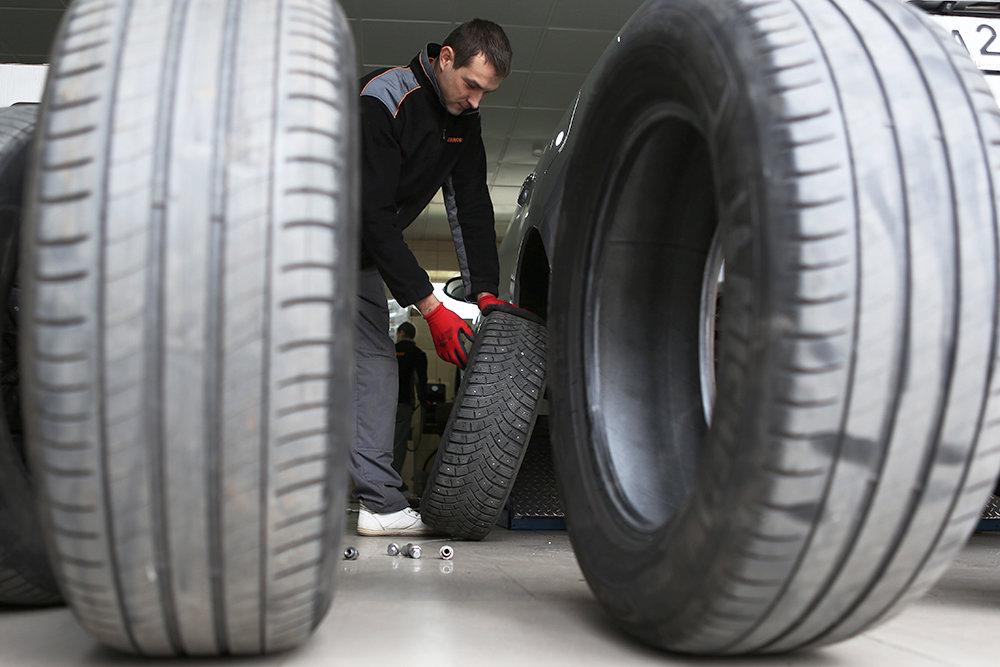A slow tire leak is more than just a nuisance. A leak can lead to low tire pressure. Not to mention, prolonged running on an underinflated tire can lead to more extensive tire damage or even cause a dangerous blowout.
If you’re experiencing a slow leak, here are some things to look for:A tire puncture: It is a common misconception that a puncture will cause the tire to immediately go flat. However, in many cases the object that caused the puncture remains lodged in the tire and prevents the air from leaking out quickly. As with all tire leaks, it is important not to ignore a puncture. Eventually the object will either wear down and/or work its way out of the tire. For more on this read our article How to Repair a Tire with a Safe, Permanent Fix.
Wheel damage: Another common cause for slow tire leaks is damage to the area where the tire bead meets the rim. This type of damage is typically cause by the driver hitting the curb, taking a speed bump at high speeds OR those dreaded potholes! The impact deforms the wheel’s metal surface which may cause the tire to pull away from the mounting surface of the wheel.
Valve stem damage: The third most common cause for slow tire leaks is worn out or damaged valve stems. Time, use and exposure to elements can cause your valve stems to wear out and cause leaks.
Diagnosing your tire leak:
If your vehicle is equipped with TPMS, you will know right away if you have a leak. If the sensor light on your dashboard goes off, you inflate all the tires back to proper pressure and the light goes back on a few days later – you likely have a leak. If your vehicle does not have TPMS, its important to check your tire pressure regularly.
Once you’ve identified that you have a leak, use TECH Chek to locate the source of your leak. Simply spray the product all around the tire. Where the surface of the tire begins to bubble is likely the source of your leak.
Where the surface of the tire begins to bubble is likely the source of your leak.
It’s important to have your tire diagnosed by a professionally trained tire shop or mobile tire repair service as soon as possible. In the case of a puncture, you may want to use a tire repair kit to keep your tire properly inflated until you can have it serviced. The leak should then be permanently fixed using a proper tire repair consisting of a cured rubber stem and repair unit.
If the leak is caused by a damaged valve, a trained tire technician can typically replace the valve at a minimal cost. In some cases, however, the tire may need replaced.
If the leak is caused by a damaged wheel, a tire technician may be able to reseat and seal the tire using a bead sealer. However, if the damage to the wheel is significant, unfortunately that means you may need to replace the wheel itself.
To read more about the types of damage that can and cannot be repaired, click here!
Not only is having slow leaks in your car tires annoying, but it can also compromise your road safety, fuel economy, and tires' lifespan.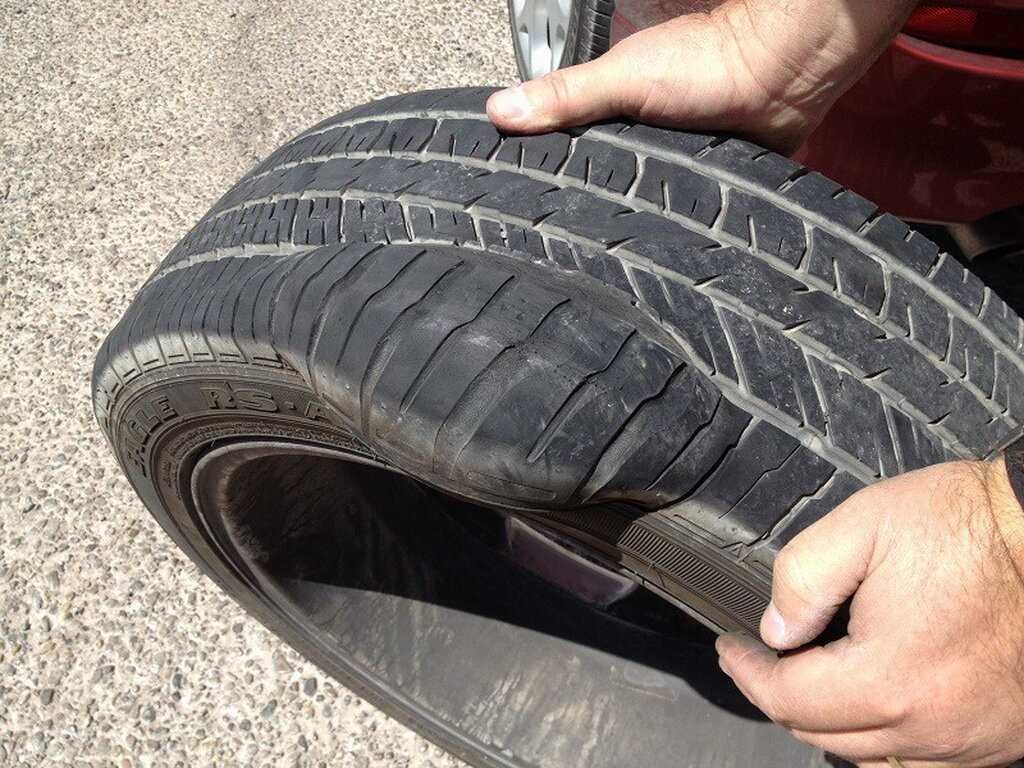 There are several common causes of slow tire leaks, and it's not always easy to determine which is affecting your tires.
There are several common causes of slow tire leaks, and it's not always easy to determine which is affecting your tires.
Learn how to tell if your tire is losing air, what can cause the issue, and how to stop slow leaks for good.
Tires naturally lose about 1 psi of air per month and should be monitored regularly. A slow tire leak occurs when your tire gradually loses more than this typical air loss. Over time, air leakage can cause a flat or underinflated tire. The source of the leak can be challenging to detect, and unlike a big tire puncture, you'll rarely hear hissing noises when they occur. Each part of a tire is susceptible to slow leaks, making the cause of air loss that much harder to detect.
The first thing you'll probably notice is an illuminated Tire Pressure Monitoring System (TPMS) warning signal on your dashboard, if equipped. The TPMS monitors tire pressure and notifies you when there's a significant PSI issue.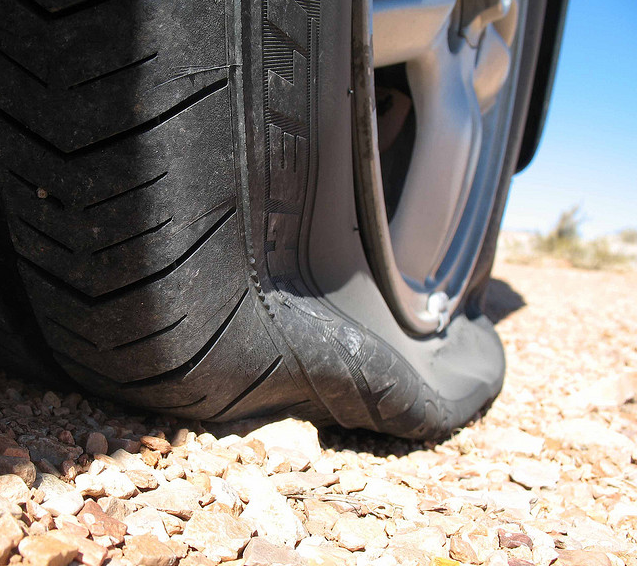
If your TPMS sensor frequently lets you know that one or more of your tires are low in pressure, the chances are likely that you have a slow leak. You can inflate your tires on your next gas pump visit, but if the problem persists, stop by your local Firestone Complete Auto Care center and let us have a look.
Many drivers wonder, “why do my tires keep losing air?” But, slow tire leak causes vary from tiny punctures to wheel and valve stem damage. Whatever the cause, it's essential to prevent air leakage. Driving on a tire with a slow leak can worsen its condition and impair your vehicle's handling, which can be dangerous.
Here are the most common reasons for slow-leak tires.
Tire punctures don't always result in immediate flats or blowouts. In fact, sharp objects like nails, screws, rocks, broken glass, and other road debris can get lodged in the tire and keep the tire "functional" as the air is slowly leaking. Other times, a sharp object may make a tiny hole and fall out, but you may not notice the immediate effect since the puncture is mild.
Other times, a sharp object may make a tiny hole and fall out, but you may not notice the immediate effect since the puncture is mild.
If your tire is still in good shape and the puncture is repairable, Firestone Complete Auto Care tire repair experts may be able to patch your tire. The solution may be as simple as a tire patch and plug if the puncture is addressed early on.
The valve stem is a part of the wheel that helps regulate tire air pressure. You can release the air or inflate your tires through it. This valve stem is comprised of a few different parts, mainly the valve stem core and the valve stem cap. If you lose the cap, dirt and debris may get stuck around the valve stem core, which can cause air leakage. The valve stem can also become corroded, brittle, or cracked due to combinations of moisture, road salt, chemicals, and age.
It's a good idea to replace your valve stems every time you get a new set of tires. That way, you can help prevent this issue and save yourself the headache of slow tire leaks.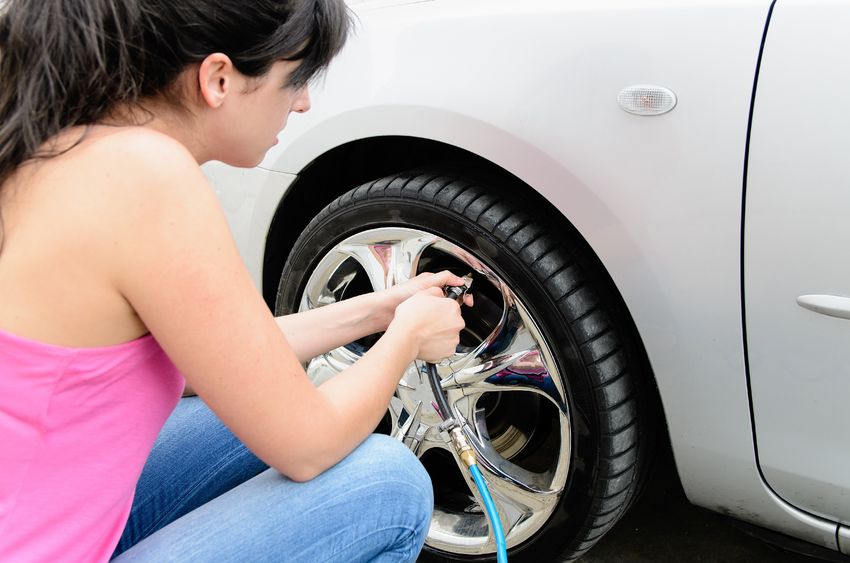 That's why our technicians at Firestone Complete Auto Care replace rubber valve stems or install the TPMS service kits with every new tire installation!
That's why our technicians at Firestone Complete Auto Care replace rubber valve stems or install the TPMS service kits with every new tire installation!
Slow tire leaks can also occur where the tire bead meets the wheel's rim. The tire bead should snugly fit the rim because it seals the tire to the wheel for proper inflation. However, the rim can corrode from exposure to road salt and other aggressive agents, leading to tiny crevices where air can escape through the bead-rim connection.
Rim leaks can also result from damaged wheels. So, if you hit a curb or hit a pothole, your slow leaks may come from a damaged rim. Whatever the cause of tire bead leaks, Firestone Complete Auto Care technicians can get to the bottom of it. We can reseat the tire bead or replace the wheels or replace the tire if necessary. Not all tire bead leaks require replacing the wheel, but some do.
Tire damage can develop due to normal wear over their lifespan.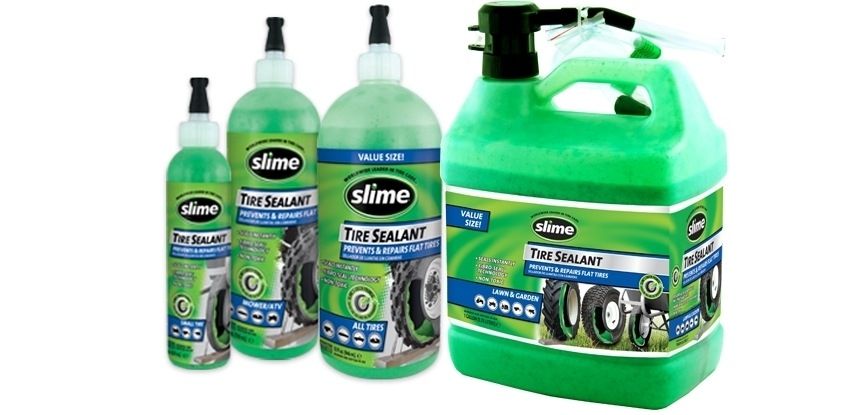 Sometimes there is nothing you can do but install new tires. The tread on your tires can wear down, leading to reduced traction and potentially dangerous driving conditions. But worn-down tires can also start leaking air through tiny cracks. Tires should generally be replaced every 25,000 to 50,000 miles, depending on tire condition, the vehicle manufacturer, driving habits, and local road conditions.
Sometimes there is nothing you can do but install new tires. The tread on your tires can wear down, leading to reduced traction and potentially dangerous driving conditions. But worn-down tires can also start leaking air through tiny cracks. Tires should generally be replaced every 25,000 to 50,000 miles, depending on tire condition, the vehicle manufacturer, driving habits, and local road conditions.
Shop tires by vehicle, tire size, and tire type, and book an installation appointment at your local Firestone Complete Auto Care shop today.
To stop a slow leak from a car tire, you first need to diagnose the issue. Then, the tire, wheel, or valve stem can either be repaired or replaced. To diagnose a slow leak yourself, apply soapy water on the tire treads, sidewalls, around the valve stem, and the tire bead area. Leave the soapy tire for a few minutes, and then inspect it for any localized bubbly patches.
Finding slow air leaks can be very tricky so don't feel discouraged if you fail to do it yourself.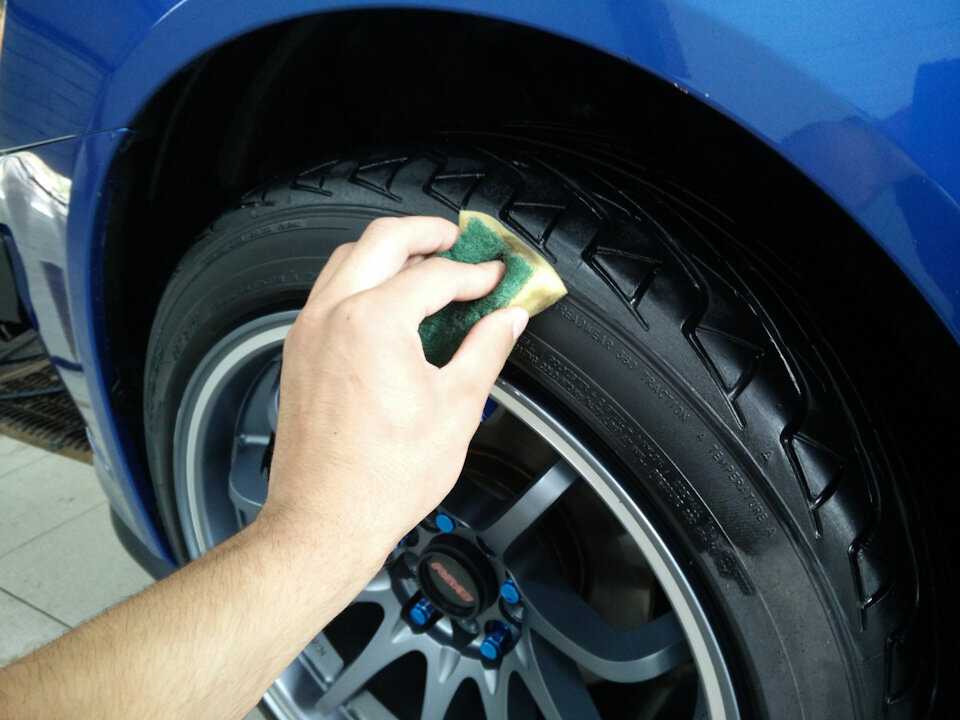 Visit any of our centers, and our experienced technicians will detect the issue promptly.
Visit any of our centers, and our experienced technicians will detect the issue promptly.
Slow tire leaks are challenging to address, so we recommend scheduling an appointment at your local Firestone Complete Auto Care and letting our experts do everything for you. Our Firestone technicians will provide you with a free courtesy check or a complete vehicle inspection. It's our goal to help you get your car in tip-top shape. Schedule your appointment, and we'll fix your tires’ slow air leaks in no time. Most of our stores are open nights and weekends, so we are usually available when you are.
It happens that a tire loses pressure for no apparent reason and you can’t understand what’s wrong, because you can’t see any punctures or damage ... What’s the problem? Someone may think that supernatural forces intervened, but most likely there is a more logical explanation for the loss of pressure. Find out why seemingly intact tires can lose air pressure and what you can do to keep unexpectedly flat tires from spoiling your mood!
Find out why seemingly intact tires can lose air pressure and what you can do to keep unexpectedly flat tires from spoiling your mood!
Even if the tires are not used, the rubber in the tires ages over time. Just as expired products can look fresh in packaging, old tires can look like new but lack their durability and performance. This is why many tire manufacturers recommend taking tires out of service after 6-10 years from the date of manufacture, even if they have never been used!
Over time, the rubber in tires loses its properties, small, barely noticeable cracks may appear in it. They can be difficult to detect and even more difficult to repair. Air leaks slowly through microcracks in the rubber. If you suspect that one of your tires has cracked due to aging, you should contact a specialist to check its condition.
Tire age is not the only thing that can cause micro cracks in tires.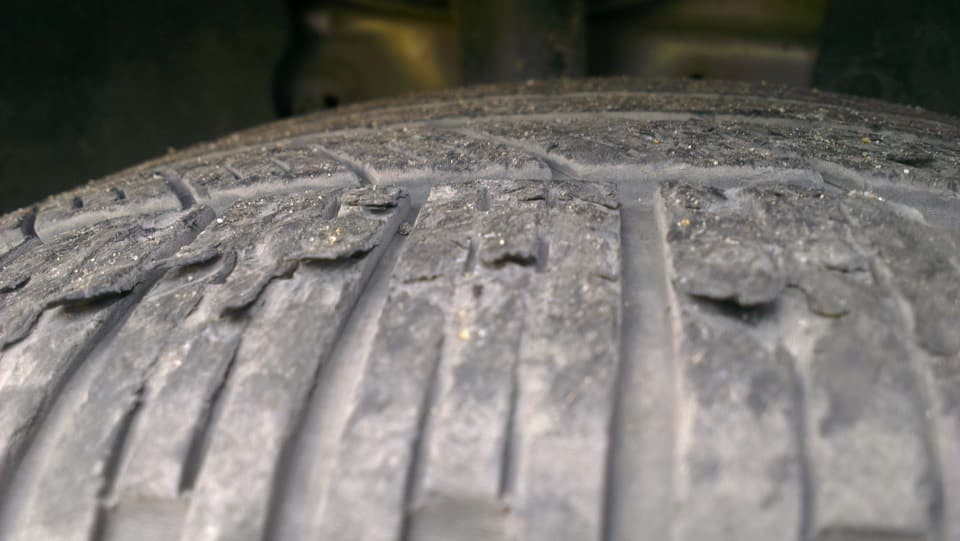 Dry rot can also damage the integrity of the rubber compound that tires are made from! But what is dry rot? Dry rot is a term that describes the fragility of a tire, which is caused by degradation of the rubber compound from which the tire is made.
Dry rot can also damage the integrity of the rubber compound that tires are made from! But what is dry rot? Dry rot is a term that describes the fragility of a tire, which is caused by degradation of the rubber compound from which the tire is made.
Unlike dry wood rot, tire rot is not caused by fungi or bacteria. Dry rot of a tire occurs as a result of exposure to external conditions that adversely affect the composition of the rubber compound of the tire. As a result, the tire dries out, which is the cause of cracks and flaking.
Proper tire care and regular inspection will help prevent dry rot. If you plan to leave the car parked for a long period of time, check the tire pressure at least once a month and inflate them if necessary. Make sure tires are out of direct sunlight.
Make sure tires are out of direct sunlight.
When storing tires for a long time, use special covers. We previously talked about how to properly store tires here.
If you notice signs of dry rot on your tire, usually small spider web-like cracks located on the sidewall of the tire, contact your tire shop for advice on what to do next.
You changed a tire and after only a few miles it started to deflate, with no punctures on the tread and no damage to the sidewalls - anyone would think that this is some kind of curse! But not the one who knows that the problem may also lie in a faulty valve.
The valve is a wheel element that allows you to adjust the air pressure in the tire. The valve consists of several parts, including the body, spool and cap. The spool allows air in and out, and the cap keeps debris out of the valve.
Wheel valve rubber housings can crack due to age, moisture, temperatures, road salt and even UV rays! The spool can also wear out and become unusable.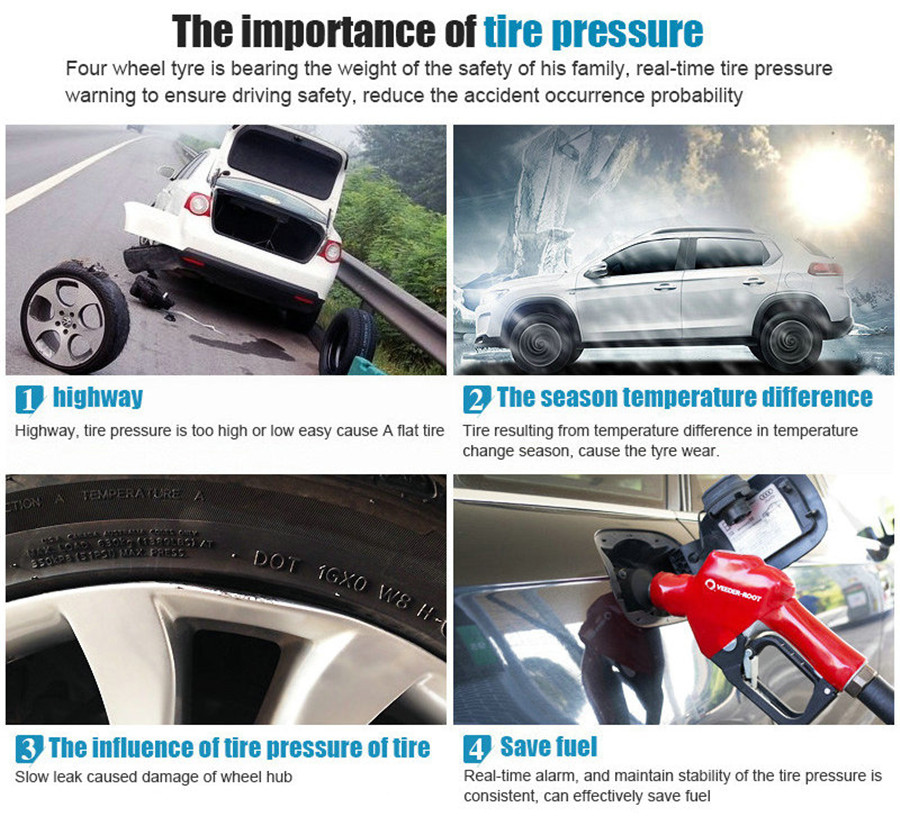 A valve that is damaged in any way may leak air.
A valve that is damaged in any way may leak air.
Wheel valve problems can be avoided by replacing them every time the tires are changed in season!
The tire bead is a structural part of the tire, which is a hard rubber edge, thanks to which the tire is securely fastened to the rim. The tire beads are made of special rubber compounds reinforced with metal. This structural element of the tire must ensure a tight and hermetic fit of the tire to the rim.
Air leaks around the bead may result from improper tire installation. Damaged, bent or corroded discs can also cause the tire to loosen to the disc and leak air. In addition, loss of rim pressure can occur after hitting pits at speed, hitting a curb, and other abnormal situations when the wheel is impacted.
It is possible that the tire pressure monitoring system (TPMS) is the reason why you think that your tires are losing pressure, when in reality the pressure is normal.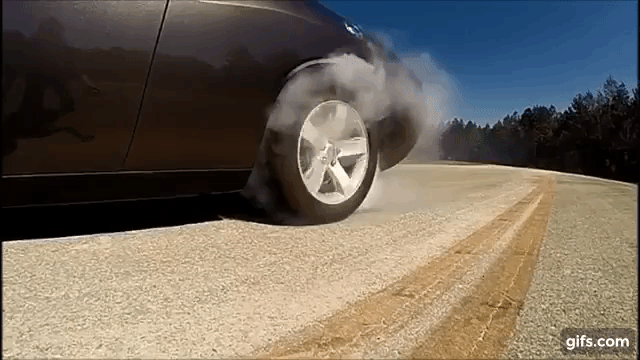 But can the tire pressure monitoring system itself be faulty? While this rarely happens, yes it is possible.
But can the tire pressure monitoring system itself be faulty? While this rarely happens, yes it is possible.
The TPMS system has sensors that warn if the tire pressure falls below a certain threshold. When the tires are under-inflated, the TPMS system will activate an indicator on your vehicle's dashboard.
However, if you see a light on, in rare cases, this may not mean that you have a flat tire - there may be a problem with TPMS!
TPMS malfunctions can be caused by a variety of factors, including wiring problems, weak batteries in sensors, or software glitches. If you see constant TPMS messages about flat tires, and when you inspect the tires, you do not find signs of pressure loss, contact a specialist to check the TPMS system.
1. What happens if I remove the sensors from the wheels?
A warning will appear on the screen. There is no way to get rid of this warning other than removing the sensor code from the driver display.
2. If one sensor in the system stops working, can I replace it?
Yes, each sensor has a unique identification code, just program a new sensor on the display, it will automatically replace the old one. But first, try replacing the battery.
3. Do I need to reprogram the sensors after a tire rotation?
No. The vehicle owner must rotate the tires after a certain mileage, but if the rims are used in the same places as before rotation, the display will not need to be reprogrammed.
4. Can the sensors interfere with each other?
Each INCAR TPMS sensor has its own unique code, just like each car has its own VIN number. The sensors send signals independently of each other, and it takes very little time to transmit the signal, so the chance of mutual interference is extremely low.
5. I am having trouble recognizing the sensor, what could be causing it?
This problem can occur when using an extension on the valve stem.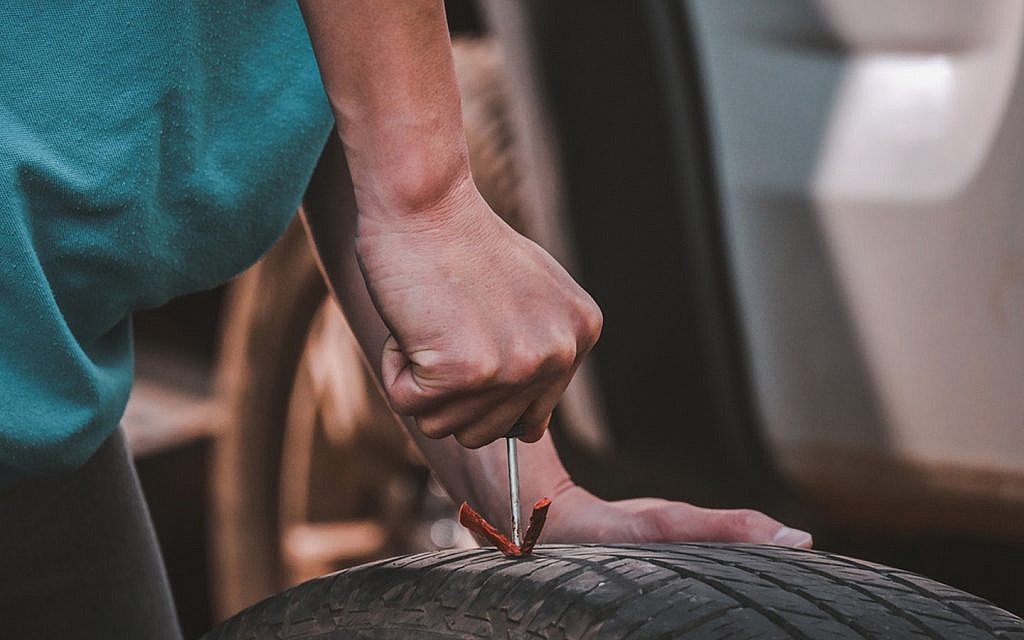 First, remove the extension and install the sensor directly on the stem, this usually solves the problem.
First, remove the extension and install the sensor directly on the stem, this usually solves the problem.
6. Why is there no pressure or temperature reading on the LCD, only the tire icon is flashing?
Sensors transmit pressure and temperature every 5 minutes. The display will stop showing pressure and temperature if it does not receive a signal from the sensor for more than an hour. It's probably time to replace the battery.
7. How can I turn off the low pressure warning on the screen?
Inflate the tire marked on the display to the correct pressure.
8. The TPMS display gives a low pressure warning when I start the car, but after a few minutes of driving the alarm goes off.
In cold weather, the sensor receives a pressure value that is lower than the specified one. As you ride, the air inside the tires heats up and the pressure increases proportionally. Try expanding the tire pressure range from the lower limit.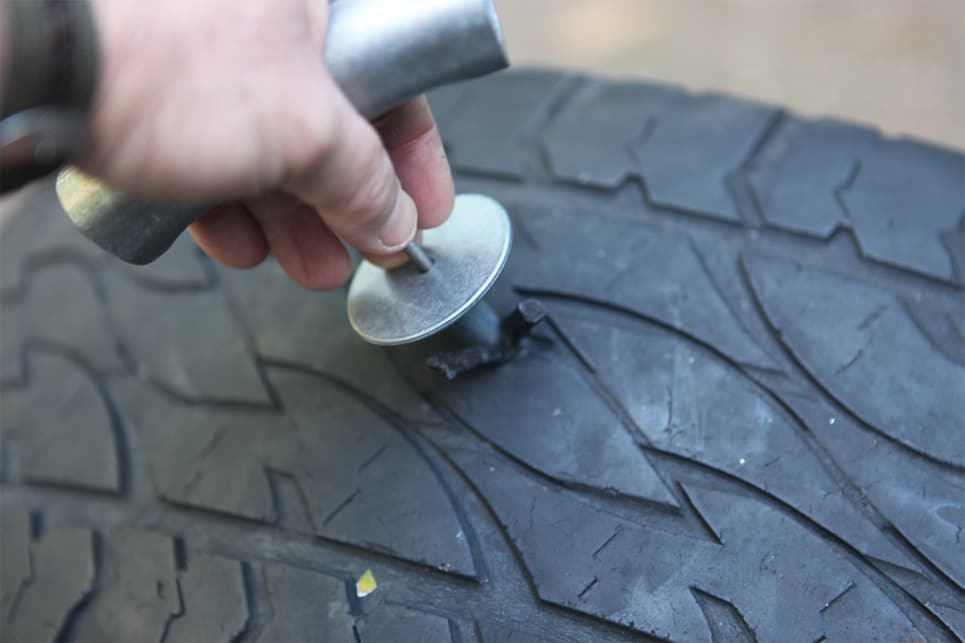
9. Will the sensor cause tire wear?
No problems with wheel balancing. On the contrary, due to the constancy of the nominal pressure in the tire, its wear will be minimal.
10. A few weeks ago I filled up the tires and everything was fine, but now the display shows me that the tires are low pressure.
Trust the INCAR TPMS sensors. Either the average daily temperature in your area has dropped due to the change of season, or there has been a natural air leak. First you need to pump up the tires.
11. Can the display be reset to factory settings?
Yes, to restore factory default settings, turn off the display, press the Set button and turn on the display. The red indicator will turn off and the factory settings will be restored.
12. I have an alarm on the display, what should I do?
First, park in a safe place on the side of the road. Find out which wheel is causing the alarm by checking the icons on the display as well as the type of alarm. For example, it could be overpressure in a tire, which is related to base pressure settings - overheating can occur after a long break from driving on a hot day. Referring to the instructions, you will accurately determine the source of the problem and its exact location. Do not continue driving until the display returns to normal.
For example, it could be overpressure in a tire, which is related to base pressure settings - overheating can occur after a long break from driving on a hot day. Referring to the instructions, you will accurately determine the source of the problem and its exact location. Do not continue driving until the display returns to normal.
13. I received a low battery alarm, what should I do?
Eventually, all batteries run out. Three sensors from the INCAR TPMS range have replaceable batteries that can be easily replaced if needed. The CR1632 type battery is available from electronics stores or online. Two more sensor models do not allow you to change batteries - you will have to buy new sensors.
14. What is the display sleep mode?
If the display is left idle for more than 15 minutes, it turns off to conserve battery power. When it detects movement again, it will beep and the screen will come to life, indicating the exit from sleep mode. If the display was turned off overnight (which is optional), simply turn it on before leaving the parking lot and the tire pressure and temperature will be updated every 5 minutes again. Even if your display is in sleep mode, the INCAR TPMS system will always monitor the tires and will give an alarm if the pressure or temperature is no longer within the set parameters.
If the display was turned off overnight (which is optional), simply turn it on before leaving the parking lot and the tire pressure and temperature will be updated every 5 minutes again. Even if your display is in sleep mode, the INCAR TPMS system will always monitor the tires and will give an alarm if the pressure or temperature is no longer within the set parameters.
15. I receive a hard braking alarm, what should I do?
When the tire is under extreme load, a slow leak signal can be obtained. The fact is that at first the pressure in the tire jumps up, and then decreases over a short period of time. This situation is similar to a slow loss of air, and it often occurs when there is water inside the tire.
16. Everything is working too well, how can I test the INCAR TPMS system?
The switched on display should be left in the driver's cab, and the sensors should be unscrewed one by one and re-tightened on the valve stem. The fast leak alarm should activate and then stop when the sensor is returned to the wheel. The beep is loud enough that you can hear it.
The fast leak alarm should activate and then stop when the sensor is returned to the wheel. The beep is loud enough that you can hear it.
17. Are there any special recommendations for winter storage of INCAR TPMS equipment?
It's a good idea to remove the sensors and display from your car if it's been parked for a long time, especially in cold weather. Keep the system in a warm place, as you will significantly extend the life of the batteries. Number the sensors or put them in an egg carton so they can be put back on the same wheels. This way you avoid having to do a new setup. The sensors do not use power unless they are mounted on the wheel.
18. How will the driver's display behave if the sensors are installed on only part of the vehicle's wheels?
The INCAR TPMS cycles through the tires. As the cycle progresses, the tire symbol flashes on the display to indicate that that particular tire is being tested. You will see the exact pressure and temperature for that tire. The display will then automatically move to the next wheel on which the sensor is installed. You will only get readings for tires equipped with sensors, the rest will be skipped and will not take time.
The display will then automatically move to the next wheel on which the sensor is installed. You will only get readings for tires equipped with sensors, the rest will be skipped and will not take time.
19. If you shake the driver display, you can hear something small rattling inside.
This is not a standard situation. If you feel that there is something wrong with the display, or if this sound annoys you while driving, you should have the equipment examined by our experts. But first, check the charging port on the left side to make sure it's safe.
20. How can I turn off the backlight of the display?
The backlight cannot be turned off manually as it is controlled by the ambient light sensor, but you can unplug the power cord and the display backlight will turn off automatically to conserve battery.
21. My display says that the tire pressure is 5 atm, and the pressure gauge shows 5.5 atm. What does this mean?
INCAR TPMS has been tested and certified by an external laboratory with a pressure measurement accuracy of 0.